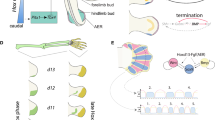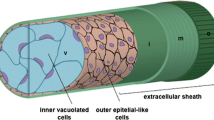Abstract
The capability of regenerating posterior segments and pygidial structures is ancestral for annelids and has been lost only a few times within this phylum. As one of the three major segmented taxa, annelids enable us to monitor reconstruction of lost tissues and organs. During regeneration, regional identities have to be imprinted onto the newly formed segments. In this study, we show spatial and temporal localization of expression of nine Hox genes during caudal regeneration of the polychaete annelid Platynereis dumerilii. Hox genes are homeodomain genes encoding transcriptional regulators of axial patterning in bilaterian animals during development. We demonstrate that five Platynereis Hox genes belonging to paralog groups (PG) 1, 4, 5, 6, and 9–14 are expressed in domains of the regenerating nervous system consistent with providing positional information along the anteroposterior axis of the regenerate. We report that expression in regenerating neuromeres is limited to varying subsets of perikarya, called gangliosomes. Four of nine genes analyzed do not appear to be involved in axial patterning. Two genes, Pdu-Hox2 and Pdu-Hox3, are predominantly expressed in the growth zone region. For some Hox genes expression in newly formed coelomic epithelia can be observed. Platynereis Hox genes do not exhibit temporal or spatial colinearity. Although there are some similarities to previously reported expression patterns during larval and postlarval development in Nereididae (Kulakova et al. 2007), expression patterns observed during caudal regeneration also show unique patterns.








Similar content being viewed by others
References
Abascal F, Zardoya R, Posada D (2005) ProtTest: selection of best-fit models of protein evolution. Bioinformatics 21:2104–2105
Bayascas JR, Castillo E, Munoz-Marmol AM, Salo E (1997) Planarian Hox genes: novel patterns of expression during regeneration. Development 124:141–148
Bely AE (2006) Distribution of segment regeneration ability in the Annelida. Integr Comp Biol 46:508–518
Bienz M (1994) Homeotic genes and positional signalling in the Drosophila viscera. Trends Genet 10:22–26
Carapuco M, Novoa A, Bobola N, Mallo M (2005) Hox genes specify vertebral types in the presomitic mesoderm. Genes Dev 19:2116–2121
Dorsett DA (1978) Organization of the nerve cord. In: Mill P (ed) Physiology of annelids. Academic, London
Duboule D (2007) The rise and fall of Hox gene clusters. Development 134:2549–2560
Finnerty, JR, Ryan, JF, Mazza, ME, Pang, K, Matus, DQ, Baxevanis, AD, Martindale, MQ (2007) Pre-bilaterian origins of the Hox cluster and the Hox code: evidence from the sea anemone, Nematostella vectensis. PLoS One 2:e153
Fröbius AC, Matus DQ, Seaver EC (2008) Genomic organization and expression demonstrate spatial and temporal Hox gene colinearity in the lophotrochozoan Capitella sp. I. PLoS One 3:e4004
Gardiner DM, Bryant SV (1996) Molecular mechanisms in the control of limb regeneration: the role of homeobox genes. Int J Dev Biol 40:797–805
Hauenschild, C, Fischer, A (1969). Platynereis dumerilii. Grosses Zoologisches Praktikum, 10b
Herlant-Meewis H (1964) Regeneration in annelids. Adv Morphog 4:155–215
Hofmann D-K (1966) Untersuchungen zur Regeneration des Hinterendes bei Platynereis dumerilii (Audouin et Milne-Edwards)(Annelida, Polychaeta). Zool Jb Physiol 72:374–430
Huelsenbeck JP, Ronquist F (2001) MRBAYES: Bayesian inference of phylogenetic trees. Bioinformatics 17:754–755
In der Rieden PM, Jansen HJ, Durston AJ (2011) XMeis3 is necessary for mesodermal Hox gene expression and function. PLoS One 6:e18010
Irvine SQ, Martindale MQ (2000) Expression patterns of anterior Hox genes in the polychaete Chaetopterus: correlation with morphological boundaries. Dev Biol 217:333–351
Kourakis MJ, Martindale MQ (2001) Hox gene duplication and deployment in the annelid leech Helobdella. Evol Dev 3:145–153
Kourakis MJ, Master VA, Lokhorst DK, Nardelli-Haefliger D, Wedeen CJ, Martindale MQ, Shankland M (1997) Conserved anterior boundaries of Hox gene expression in the central nervous system of the leech Helobdella. Dev Biol 190:284–300
Krumlauf R (1994) Analysis of gene expression by northern blot. Mol Biotechnol 2:227–242
Kulakova M, Bakalenko N, Novikova E, Cook CE, Eliseeva E, Steinmetz PRH, Kostyuchenko RP, Dondua A, Arendt D, Akam M, Andreeva T (2007) Hox gene expression in larval development of the polychaetes Nereis virens and Platynereis dumerilii (Annelida, Lophotrochozoa). Dev Genes Evol 217:39–54
Kulakova MA, Cook CE, Andreeva TF (2008) ParaHox gene expression in larval and postlarval development of the polychaete Nereis virens (Annelida, Lophotrochozoa). BMC Dev Biol 8:61
McGinnis W, Krumlauf R (1992) Homeobox genes and axial patterning. Cell 68:283–302
Miller, MA, Pfeiffer, W, Schwartz, T (2010) Creating the CIPRES Science Gateway for inference of large phylogenetic trees. Proceedings of the Proceedings of the Gateway Computing Environments Workshop (GCE), New Orleans, LA, 14 November 2010
Morgan TH (1901) Regeneration. Macmillan, New York
Müller MC (2006) Polychaete nervous systems: ground pattern and variations—cLS microscopy and the importance of novel characteristics in phylogenetic analysis. Integr Comp Biol 46:125–133
Müller MC, Henning L (2004) Ground plan of the polychaete brain—I. Patterns of nerve development during regeneration in Dorvillea bermudensis (Dorvilleidae). J Comp Neurol 471:49–58
Müller MCM, Westheide W (2002) Comparative analysis of the nervous systems in presumptive progenetic dinophilid and dorvilleid polychaetes (Annelida) by immunohistochemistry and cLSM. Acta Zool 83:33–48
Müller MCM, Berenzen A, Westheide W (2003) Experiments on anterior regeneration in Eurythoe complanata ("Polychaeta", Amphinomidae): reconfiguration of the nervous system and its function for regeneration. Zoomorphology 122:95–103
Pfannenstiel HD (1984) The ventral nerve cord signals positional information during segment formation in an annelid (Ophryotrocha puerilis, Polychaeta). Wilhelm Rouxs Arc Dev Biol 194:32–36
Sanchez Alvarado A (2000) Regeneration in the metazoans: why does it happen? Bioessays 22:578–590
Seaver EC, Kaneshige LM (2006) Expression of 'segmentation' genes during larval and juvenile development in the polychaetes Capitella sp. I and H. elegans. Dev Biol 289:179–194
Smith JE (1956) Some observations on the neuron arrangement and fibre patterns in the nerve cord of nereid polychaetes. Pubbl Stn Zool Napoli 27:168–188
Smith JE (1957) The nervous anatomy of the body segments of nereid polychaetes. Phil Trans B 240:135–196
Tamura, K, Peterson, D, Peterson, N, Stecher, G, Nei, M, Kumar, S (2011) MEGA5: Molecular Evolutionary Genetics Analysis using maximum likelihood, evolutionary distance, and maximum parsimony methods. Mol Biol Evol 28(10):2731–2739
Tanaka EM (2003) Regeneration: if they can do it, why can't we? Cell 113:559–562
Wong VY, Aisemberg GO, Gan WB, Macagno ER (1995) The leech homeobox gene Lox4 may determine segmental differentiation of identified neurons. J Neurosci 15:5551–5559
Yoshida-Noro C, Myohara M, Kobari F, Tochinai S (2000) Nervous system dynamics during fragmentation and regeneration in Enchytraeus japonensis (Oligochaeta, Annelida). Dev Genes Evol 210:311–319
Acknowledgements
The authors thank Brigitte Fronk and Sabine Wagner for maintenance of the Platynereis dumerilii culture and technical assistance. We gratefully acknowledge Elaine C. Seaver for the careful reading and valuable remarks. Thanks are due to unknown reviewers for valuable comments. This research was supported in part by the National Science Foundation through TeraGrid resources provided by the CIPRES portal.
Author information
Authors and Affiliations
Corresponding author
Additional information
Communicated by M. Martindale
K. Pfeifer and A. C. Fröbius contributed equally to this work.
Electronic supplementary material
Below is the link to the electronic supplementary material.
Fig. S1
Orthology assignments for Platynereis dumerilii Hox genes. Platynereis dumerilii Hox sequences are delimited by arrows. Numbers above branches indicate Bayesian posterior probabilities. Ovals delimit bootstrap support >50 at a node from either neighbor-joining (NJ) or maximum likelyhood (ML) analyses and squares show bootstrap support >50 from both NJ and ML analyses (JPEG 102 kb)
Fig. S2
Comparison of spatial expression of Hox genes of Platynereis dumerilii in adult posterior ends and during caudal regeneration. Lighter and darker colors indicate lower and higher expression levels, respectively. The red dashed line marks the amputation site for regenerates. The asterisk marks the last original segment for regenerates. nsz nascent segment zone, pgz posterior growth zone region, py pygidium (JPEG 40 kb)
Rights and permissions
About this article
Cite this article
Pfeifer, K., Dorresteijn, A.W.C. & Fröbius, A.C. Activation of Hox genes during caudal regeneration of the polychaete annelid Platynereis dumerilii . Dev Genes Evol 222, 165–179 (2012). https://doi.org/10.1007/s00427-012-0402-z
Received:
Accepted:
Published:
Issue Date:
DOI: https://doi.org/10.1007/s00427-012-0402-z




